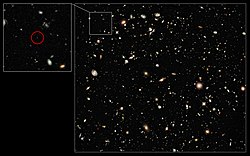| UDFy-38135539 | |
|---|---|
Hubble Space Telescope image of UDFy-38135539 | |
| Observation data (J2000 epoch) | |
| Constellation | Fornax |
| Right ascension | 03h 32m 38.13s[1] |
| Declination | −27° 45′ 53.9″[1] |
| Heliocentric radial velocity | 2,581,213 km/s |
| Distance | 13.1 billion light-years (4.0 billion parsecs) (light travel distance)[2] ~30 billion light-years (9.0 billion parsecs) (present proper distance)[3] |
| Apparent magnitude (V) | V fainter than 30.2[4] H160 = 28.1[1] (detected by HST in J and H bands)[1] |
| Characteristics | |
| Type | Dwarf |
| Number of stars | 1 billion (1×109) |
| Size | 10,000 ly (diameter) |
| Apparent size (V) | 0.0025 x 0.0012 |
| Other designations | |
| HUDF.YD3, TST2010 3, MDC2010 1721 | |


UDFy-38135539 (also known as "HUDF.YD3") is the Hubble Ultra Deep Field (UDF) identifier for a galaxy which was calculated as of October 2010[update] to have a light travel time of 13.1 billion years[2] with a present proper distance of around 30 billion light-years.
It was discovered by three teams in September 2009 in sensitive infrared Hubble Space Telescope images and identified by these as source UDF-38135539 (R Bouwens et al.[1]), source HUDF.YD3 (A Bunker et al.[5]) and source 1721 (R McLure et al.[6]), and additionally reported in the Astrophysical Journal, and the Monthly Notices of the Royal Astronomical Society. All teams independently identified the source to likely be an extremely distant galaxy because there was no measurable light at visible wavelengths (caused by absorption of hydrogen gas along the line of sight). Following the discovery of this candidate distant galaxy, another team targeted this object with ground-based spectroscopy to confirm the distance, reporting a redshift z=8.6.[4] However, attempts to replicate this observation strongly suggest the original claim was in error, meaning that at the present time the galaxy only has a photometric redshift estimate.[7]
- ^ a b c d e R.J. Bouwens; G.D.Illingworth; P.A. Oesch; M. Stiavelli; P. van Dokkum; M. Trenti; D. Magee; I. Labbe; M. Franx; M. Carollo & V. Gonzalez (2010). "Discovery of z~8 Galaxies in the HUDF from ultra-deep WFC3/IR Observations". Astrophysical Journal. 709 (2): L133. arXiv:0909.1803. Bibcode:2010ApJ...709L.133B. doi:10.1088/2041-8205/709/2/L133. S2CID 118083736.
- ^ a b Cite error: The named reference
NSwas invoked but never defined (see the help page). - ^ Cite error: The named reference
Calculatorwas invoked but never defined (see the help page). - ^ a b Lehnert, M. D.; Nesvadba, N. P. H.; Cuby, J.-G.; Swinbank, A. M.; Morris, S.; Clément, B.; Evans, C. J.; Bremer, M. N.; Basa, S. (2010). "Spectroscopic confirmation of a galaxy at redshift z = 8.6". Nature. 467 (7318): 940–942. arXiv:1010.4312. Bibcode:2010Natur.467..940L. doi:10.1038/nature09462. PMID 20962840. S2CID 4414781.
- ^ Andrew Bunker; Stephen Wilkins; Richard Ellis; Daniel Stark; Silvio Lorenzoni; Kuenley Chiu; Mark Lacy; Matt Jarvis & Samantha Hickey (2009). "The Contribution of High Redshift Galaxies to Cosmic Reionization: New Results from Deep WFC3 Imaging of the Hubble Ultra Deep Field". Monthly Notices of the Royal Astronomical Society. 409 (2): 855–866. arXiv:0909.2255. Bibcode:2010MNRAS.409..855B. doi:10.1111/j.1365-2966.2010.17350.x. S2CID 9072521.
- ^ R.J. McLure; J.S. Dunlop; M. Cirasuolo; A.M. Koekemoer; E. Sabbi; D.P. Stark; T.A. Targett & R.S. Ellis (2010). "Galaxies at z = 6 – 9 from the WFC3/IR imaging of the HUDF" (PDF). Monthly Notices of the Royal Astronomical Society. 403 (2): 960–983. arXiv:0909.2437. Bibcode:2010MNRAS.403..960M. doi:10.1111/j.1365-2966.2009.16176.x. S2CID 1646673.
- ^ VLT/XSHOOTER & Subaru/MOIRCS Spectroscopy of HUDF-YD3: No Evidence for Lyman-alpha Emission at z=8.55